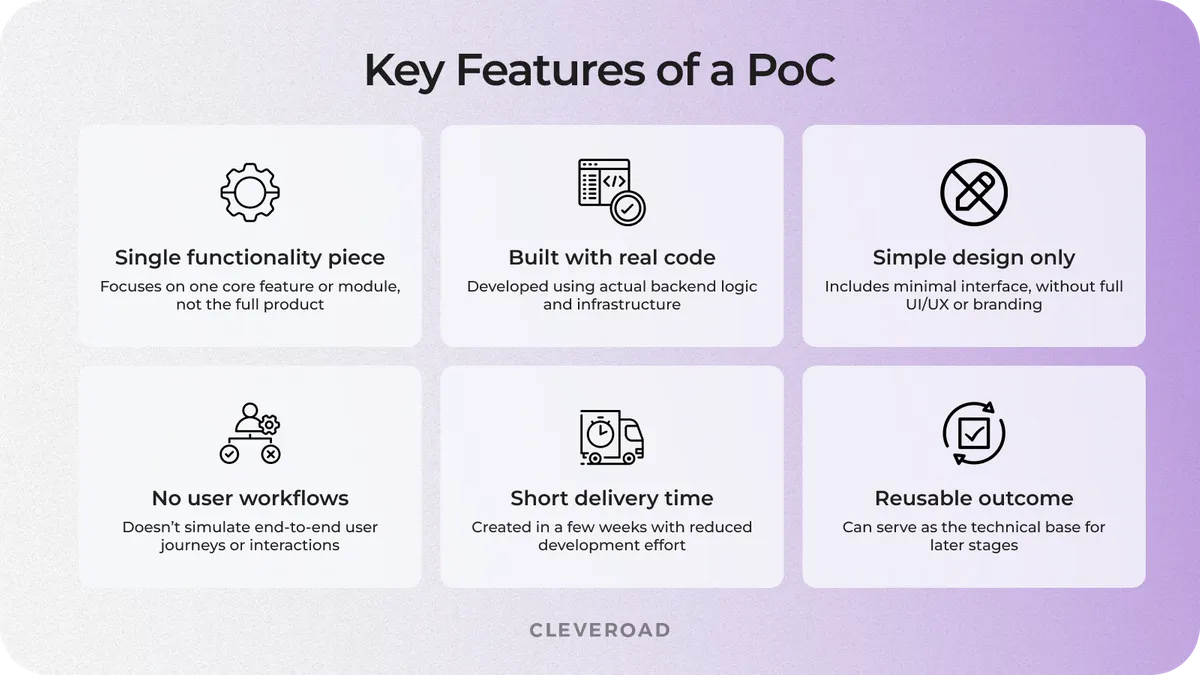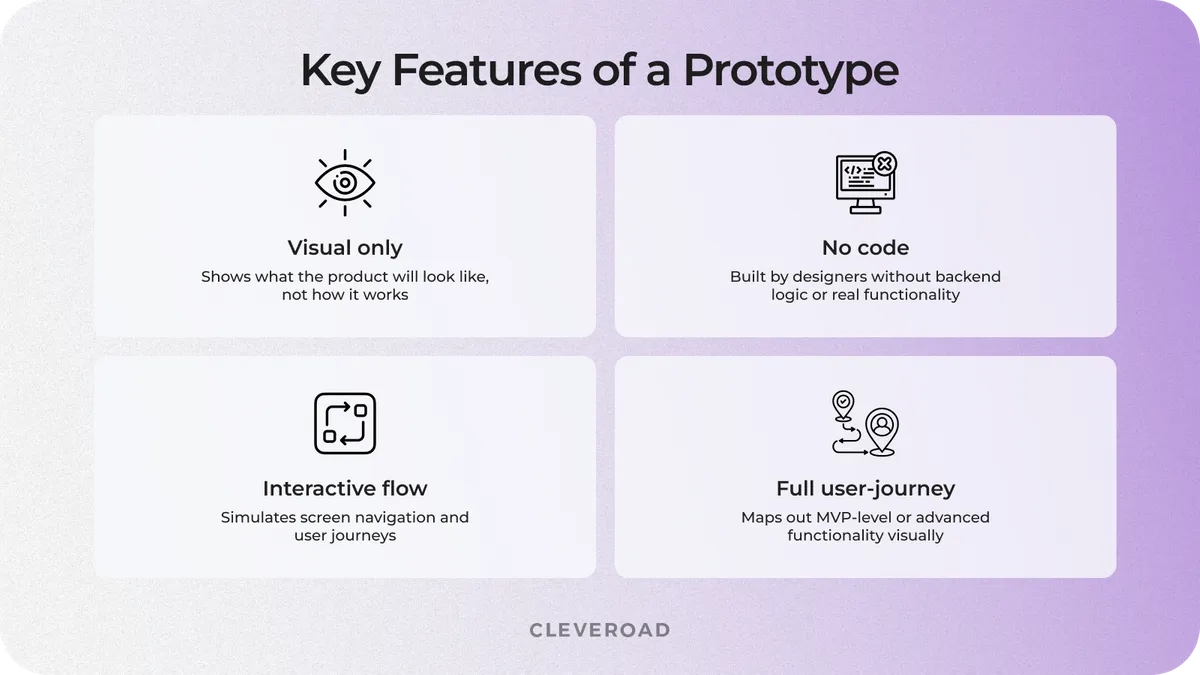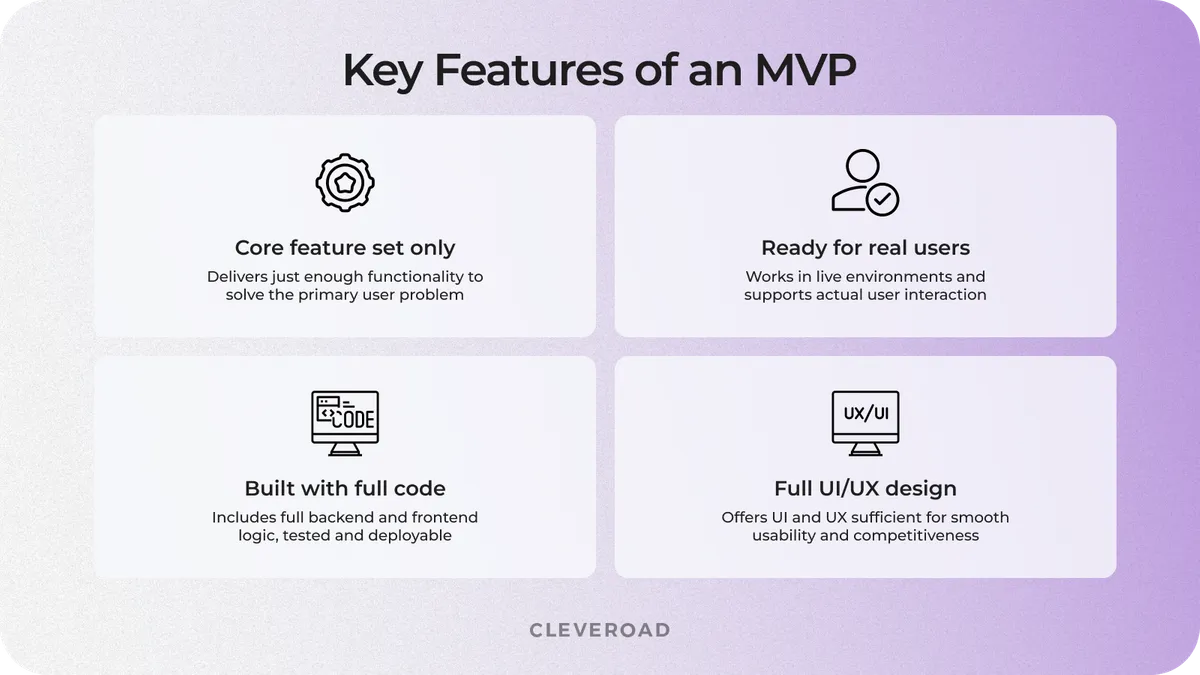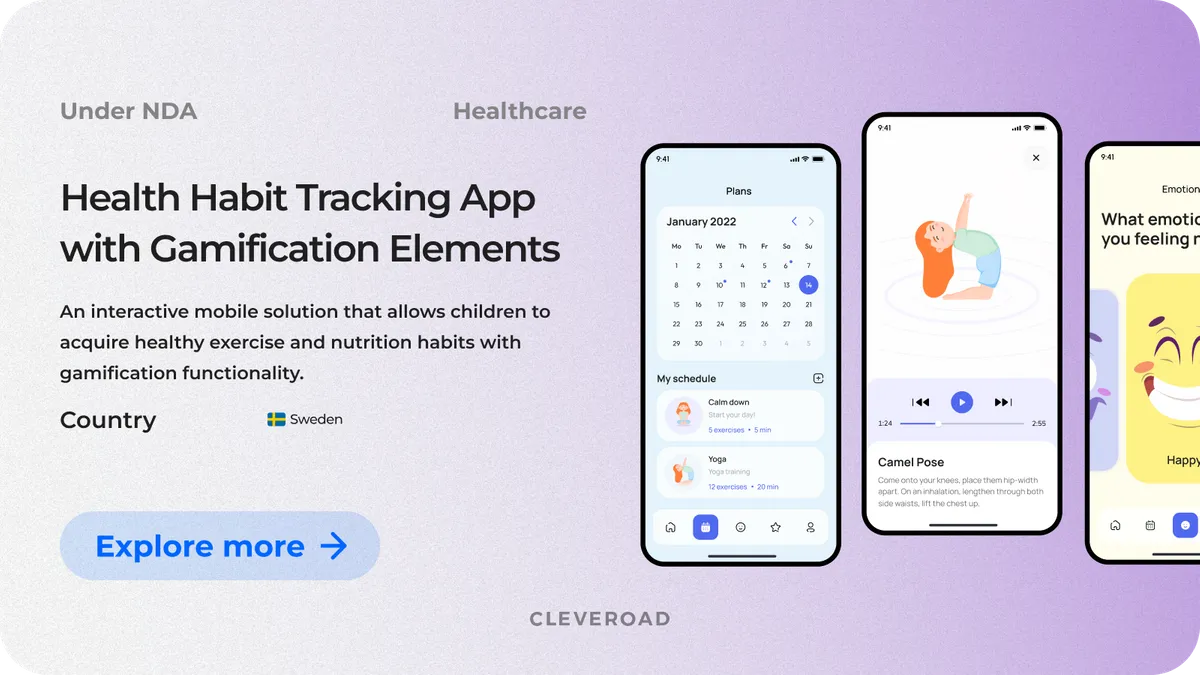PoC vs. Prototype vs. MVP: How They Differ and What to Choose for Your Project?
19 May 2025
18 Min
114 Views
What is the difference between MVP, prototype and Proof of Concept, and which approach to choose for a successful software product launch? This question is confusing most unentrepreneurs and business executives, yet it is quite important. A proper strategy allows you to meet your goals more quickly and prioritize investments where they matter.
As a software development company with 200+ successfully delivered projects, we at Cleveroad are here to help you decide between Proof of Concept vs Prototype vs MVP. In this article, we’ll discover key characteristics of each approach, unveil which goals they match, and explain how to choose the right strategy to bring your idea to reality based on our experience.
What Is a Proof of Concept?
A Proof of Concept (PoC) is the earliest functional version of a tech product, built to test a specific idea, feature, or technical approach. It focuses on one core functional module or even a single feature. A PoC is all about functionality and is created with real code, not mockups or design screens. It doesn’t include a polished interface or a complete user journey.
A PoC confirms that your idea can work in a real environment, helping you avoid investing in a solution with no real impact. PoCs are especially useful when you consider implementing emerging technologies or complex integrations, like Artificial Intelligence (AI), blockchain, or cloud computing. A PoC helps you identify the use case with the strongest business impact for AI projects before investing in full development. It's the smartest way to reduce risk and move forward with confidence.
Let's dive deeper into the key features of Proof of Concept.
Key PoC characteristics
A proof of concept isn't just a sketch or a presentation — it's a working slice of your product's logic built to test its performance and business impact. PoC is the first real checkpoint from idea to market, answering the question: Can this idea work in practice?

Main characteristics of Proof of Concept
The difference between PoC and MVP lies in the functionality scope and purpose. PoCs are deliberately lean, focused, and not customer-facing. They aren't suitable for showcasing design, UX flow, or branding. Instead, they offer technical clarity. If the PoC delivers positive results, it becomes a starting point for full-featured development. If it fails, it protects you from scaling an idea that was never technically viable.
When comparing PoC vs prototype, a PoC is built with real code to validate one high-risk feature or technology, while a prototype is a visual simulation focused on UI and user flows. In most cases, a PoC runs with no user interface at all. However, for certain use cases, for instance, for PoC to test the feasibility of AI automation in Healthcare, your software vendor may deliver a very simple, approximate UI to support the tested logic and allow you to test the software on real workflows. PoC design is strictly functional. It doesn't reflect how the final product will look or feel, and doesn't aim to deliver a seamless user experience.
The development team behind a PoC typically includes:
- Software developers
- A Solution Architect
- A UI/UX designer (optional)
- DevOps support (optional)
They build a minimal but working module, often one that will later be reused or restructured within the minimum viable product development.
! Note: After a PoC, you can either move on to prototyping to visualize the full solution’s design and flow, or proceed directly to MVP development to turn your concept into a working product.
When is it better to choose PoC?
We’ve already discovered how does a proof of concept differ from a prototype or MVP, so let’s now unveil the reasons you should start your software creation with PoC development. Here's when PoC is the smartest choice for your product strategy:
- Validate your idea. A PoC helps you move beyond assumptions by proving that your concept works in practice. According to a study by Start-Up Nation Central, approximately 80% of PoCs in the corporate funnel succeed in validating the concept.
- Build stakeholder trust. Whether pitching to investors or aligning your internal team, a functional PoC proves your idea's worth pursuing. A working piece of functionality convinces all stakeholders that you've already taken a practical step toward your software product delivery.
- Reduce technical and business risks. A PoC lets you test a specific use case on real data to see if the model works and delivers business value. Investor’s Business Daily claims that despite significant investments in research and innovation, approximately 90% of new product launches fail. Starting with PoC helps you reduce risks and stay in the 10% of successful projects.
- Prepare for the next development stage. A successful PoC gives you a solid technical foundation to move forward confidently. It helps refine the architecture, reduce uncertainty, and speed up future stages like prototyping, MVP development, or full-fledged software launch.
- Save time and budget. A PoC allows you to explore the technical direction without committing to full design or development. You invest only in what matters most at this stage. Moreover, according to PwC, starting with a PoC can deliver 2x ROI through value-based evaluation and help uncover high-impact use cases that traditional approaches might overlook.
Planning to kick-start an AI project but not sure about your idea? Our AI PoC services are here to help!
What Is a Prototype?
A prototype is a visual draft of your future product software aimed at demonstrating its appearance and business logic before development starts. It allows you to explore a solution's structure, layout, and interaction by simulating user experience through design tools, without involving any backend code.
The difference between prototype and Proof of Concept or MVP lies in its focus on form over function. You're not testing feasibility — you're shaping and validating how users will interact with your product. Prototypes help catch UX flaws, refine the interface, and align teams before investing in development.
You can use a prototype to visualize your MVP or even an extended long-term product functionality. Whether a simple wireframe or a clickable demo version, a prototype guides the product logic step-by-step, helping you gather early feedback and improve the user flow.
Let's look at how prototypes work and what they include.
Key prototype characteristics
A prototype gives your team a visual representation of the app's structure and flow, helping you define how it should look and behave. The difference between prototype and Proof of Concept is that a prototype contains no real functionality, logic, or server connections. It is also the main prototype and MVP difference, since prototyping focuses solely on the user experience and doesn't involve developers.

Primary characteristics of prototype
There are three common types of prototypes:
- Low-fidelity wireframes, used to quickly outline layout and content structure
- High-fidelity mockups, which simulate realistic screen transitions and design details
- Clickable demo prototypes, interactive versions that mimic user flows and navigation without connecting to live data or backend logic
Regardless of the type, a prototype aims to visualize the full user journey from first interaction to the core action and serves as a tool for alignment and validation. Designers use tools like Figma, Sketch, or Adobe XD to build screen layouts and simulate user interactions at different levels of detail.
While most prototypes reflect the MVP scope, they can also simulate advanced features to show the product's long-term direction. Such an approach supports phased development planning and helps define what to include now versus later.
! Note: If you start your project with a prototype, you can either move directly to MVP development if feasibility is clear, or run a PoC in parallel to validate a high-risk functional block.
When should you choose a prototype?
As we’ve outlined the difference between prototype and MVP, let’s clarify when you should start with the first option. According to the Engineering Science & Technology Journal, prototyping is a core part of Agile development, ensuring speed, efficiency, and alignment. If you've already validated your software idea, it's best to start with a prototype to refine the UX before coding begins.
Here are the tasks you can solve by starting your product development with a prototype:
- Visualize your product. A prototype allows you to transform raw ideas into interactive designs, allowing you to finalize app design before starting the development. Thus, you can clearly see what you’ll get after the development, and can ask potential users (focus groups or your employees) for their feedback on UX.
- Align stakeholders and attract investors. Prototype allows you to provide a complete view of what your software product will look like, allowing you to engage investors and align on app design with all product stakeholders. Eliminate guesswork and get buy-in early.
- Refine the user experience. Prototype and proof of concept have one common goal: to reduce possible development issues. While PoC is focused on coding, prototyping allows you to spot any UX problems before the development, allowing you to make changes in advance.
- Speed up development. Prototyping significantly streamlines MVP development. When the design is validated, developers work faster and more accurately, with less rework. They don’t need to waste extra time on redeveloping the user journey or design elements.
Cleveroad delivers prototypes as a part of our UI/UX design services. Learn more about our design approach and process on our service page
What Is a Minimum Viable Product?
A Minimum Viable Product (MVP) is the first functional version of your product built with just enough features to solve the core problem and deliver value to early users. The main peculiarity differentiating MVP vs PoC vs prototype is that it's a working product that users can access, test, and interact with in real conditions.
Let’s unveil the main difference between PoC prototype and MVP. A PoC confirms that a core idea can work. A prototype shows how it should look. An MVP combines both and adds enough features to launch and gather meaningful feedback from early adopters. Startups use MVPs to test product-market fit, validate monetization strategies, and gather real user feedback.
Let's take a closer look at what defines an MVP in practice.
Key MVP characteristics
An MVP is not a draft or simulation; it’s a usable product released live. It solves a real problem using a limited but focused feature set, allowing users to complete essential actions like registering, booking a service, or purchasing.

Core peculiarities of Minimum Viable Product
MVPs are intentionally limited in scope. They focus on delivering only the essential functionality — the features required to solve the user’s core pain point. Anything beyond that is deferred to future iterations. Although lightweight, an MVP must still meet key standards for performance, usability, and security. Users expect a smooth, stable experience from version one.
The prototype and MVP difference is clear: an MVP requires sprint planning, full development, QA testing, and deployment, just like any formal product launch. The MVP delivery team typically includes a Solution Architect, Business Analyst, Project Manager, UI/UX designer, backend and frontend developers, and QA engineers working collaboratively to deliver a launch-ready solution.
MVPs often build on top of previous PoC and prototype stages. That means by the time MVP development begins, your software logic is already validated, and the UI is mapped. Teams often combine PoC prototype MVP stages into a single project, starting from idea validation and visualization, and then scaling from this solid foundation.
! Note: You can cover PoC and prototyping within the first stages of MVP development. For instance, for our client from Denmark, the Cleveroad team delivered an MVP version of a Gym directory for travelers based on a clickable app prototype created during the initial project stages.
Here’s what Alexander Schrøder, Owner of TrainAway, says about cooperation with Cleveroad:


When is it better to choose an MVP?
Once your idea is clear and your design is ready, an MVP is the best way to go live, gather insights, and confidently move forward to an advanced solution. So let’s now unveil the main reasons why building a Minimum Viable Product is the best approach for your software product creation, backed by statistics gathered by Run Around Tech:
- Get to market faster. MVP development focuses only on the core features required to make a working application and satisfy target users’ needs, so it takes less time to develop and release for wider usage.
- Release a working software within a tight budget. Shorter development time positively impacts required costs, allowing you to launch your software solution with minimal investments. Run Around Tech claims that MVPs can reduce initial development costs by up to 60% compared to building a full product upfront.
- Support fundraising and traction. A working MVP shows investors you're not just planning but delivering. Showing them a real product and actual user feedback allows you to gather more investments and engage more potential stakeholders.
- Validate product-market fit. Release your MVP to your core audience and see how they respond. Use real data to guide what's next. Run Around Tech states that startups that test early MVPs are 3x more likely to pivot successfully and fit the market.
- Collect early feedback. MVP and PoC both enable you to gather feedback from users, but Minimum Viable Product reviews will be more valuable for outlining your software improvement strategy, since it is based on a fully functional solution with a well-thought-out UI and UX.
Reduce time-to-market and launch your product at a lower cost with our MVP development services
PoC vs. Prototype vs. MVP: Comprehensive Comparison
Choosing between a Proof of Concept, prototype, or a Minimum Viable Product can be confusing, especially in the early stages of product development. Each format serves a unique role in validating your idea, from testing feasibility to refining usability and launching a usable product. Understanding the difference between PoC and MVP, and how both compare to a prototype, helps you make the most efficient product decision and optimize investment.
So let's now clarify the key differences between PoC vs MVP vs prototype in one comprehensive table.
| Parameter | Proof of Concept (POC) | Prototype | Minimum Viable Product (MVP) |
Primary goal | Verify technical feasibility | Test user experience and design | Validate market demand with core functionality |
Question it answers | "Can we build it?" | "How should it work?" | "Will people use and pay for it?" |
Time to create | 3-6 weeks | 3-4 weeks | 2-6 months |
Team size | 1-2 developers, architect, project manager | Designer + Business Analyst | 3-7 team members (cross-functional) |
Approximate cost | $15,000-$30,000 | $5,000-$15,000 | $50,000-$150,000+ |
Target audience | Internal team, technical stakeholders | Internal team, UX researchers, potential users | Early adopters, real market customers |
Functional level | Limited to specific technical functionality | Simulated functionality, focus on UI/UX | Core features fully functional |
Visual fidelity | Low/None (often backend-focused) | Medium to High | Medium to High (production quality) |
Code quality | Experimental, not production-ready | Low to Medium, often disposable | Production-grade, maintainable |
Testing focus | Technical feasibility | User experience, workflows | Product-market fit, business model |
Typical output | Technical demo, experiment results | Interactive mockup, clickable design | Working product with core features |
Success metrics | Technical validation | User feedback, usability scores | Engagement, retention, conversion, revenue |
Risk level | Technical risk | UX risk | Market risk |
Next steps if successful | Move to MVP | Refine design or build MVP | Scale product with additional features |
Now let's summarize the core characteristics of Proof of Concept vs prototype vs MVP and their distinctions and use cases:
A PoC is a technical validation tool to test whether a specific concept or feature is feasible. It includes backend logic and may have a basic interface, but it doesn't prioritize UX. The difference between prototype and Proof of Concept is that the latter proves function, not form. In turn, the MVP/PoC distinction is that the proof of concept is not meant for end users. It is only used internally and typically contains only one high-risk feature, not the whole basic set.
A prototype is a visual representation of your product that is typically built after PoC validation and before MVP development. It maps out user flows, screens, and interactions — often covering even more than the MVP scope. It doesn't include any code or backend logic. The main difference between a prototype and PoC or MVP is that the prototype focuses only on user experience and interface.
An MVP is the first working version of your product available for the end users. It can combine technical logic validated during the PoC creation and testing, and UI/UX design approved during the prototyping, to deliver a usable product. A Minimum Viable Product contains a set of essential features required to fulfill the primary purpose of the application. The MVP vs PoC difference is clear: MVPs are user-facing and market-ready.
Each development approach plays a strategic role in successful software product creation. By understanding the Proof of Concept vs prototype vs MVP distinctions, you can build a product development path focused on the most value, from prototype to MVP, or from MVP proof of concept to market launch.
How to Decide Which Approach Suits You Best?
Choosing between a proof of concept, a prototype, or an MVP depends on your product maturity, technical certainty, business goals, and available resources. These development approaches aren't interchangeable — each addresses different risks and questions. Whether you're testing feasibility, refining usability, or entering the market, here's how to pick the right approach for your situation.
Define your main goal
Start by asking: What do I need to validate first — technology, usability, or market fit?
- If your idea involves complex tech or AI and you're unsure it can work on real data and bring business value, start with a proof of concept.
- If feasibility is confirmed but you're uncertain about how the product should look and behave, a prototype helps clarify the interface and user flow.
- If the concept is well-defined and ready to be tested with real users, an MVP delivers a usable product to validate market demand.
Many teams follow a structured PoC–prototype–MVP path, beginning with feasibility validation, moving to design, and ending with product launch. At Cleveroad, we support startups and businesses at every stage, from PoC development and UX prototyping to MVP delivery and scaling.
Consider the project stage
Your current position in the product lifecycle is one of the most decisive factors when choosing between a proof of concept prototype and MVP. Each format aligns with a specific stage of product maturity:
- At the early idea stage, use a PoC to validate feasibility and business impact.
- During concept refinement, move to a prototype to explore structure and interaction design.
- If your product idea is ready for the market and the UX is clear, proceed directly to MVP.
Assess budget and timeline
Each format comes with different cost and time implications:
- A PoC is fast and focused — ideal for saving time and budget by validating early assumptions.
- A prototype is a cost-effective way to refine the product’s UI/UX without investing in development.
- An MVP requires more investment but delivers a functional product and measurable ROI.
At Cleveroad, we tailor each solution to fit your timeline and budget. We offer flexible collaboration models, including IT staff augmentation, dedicated development teams, and project-based delivery. Whether you're comparing PoC vs MVP vs prototype, we help you choose the right option and build with maximum value in mind.
Recently, we partnered with the Australia Rowing Association to build an MVP version of their mobile fitness app for iOS and Android. The app features rowing workouts, highlights upcoming sports events, and helps grow the rowing community worldwide. To keep MVP development within budget, we suggested using Flutter. This allowed us to create one codebase for both platforms and cut development time and costs by 40%.
Here's what our client, Georgia Beattie, who is a non-executive director of the Australia Rowing Association, says about cooperation with Cleveroad:
Georgia Beattie, Director at Australian Rowing Association, on Successful Partnership with Cleveroad
Ask for expert advice
Still unsure which format suits your product best? That's where expert support makes all the difference. Choose a reliable software development partner with solid experience in software development and a deep knowledge of your business domain.
At Cleveroad, we offer a free Solution Design Workshop to help you turn your product idea into a clear, validated development plan before writing a single line of code. This workshop is led by our team of business analysts, solution architects, and product strategists, who work closely with you to:
- Clarify your business goals and technical needs
- Evaluate your idea's feasibility, scope, and market fit
- Choose the right approach: PoC, prototype, or MVP
- Build a detailed implementation roadmap
- Provide rough estimates for time and budget
- Define the tech stack and required team composition
Whether you're just shaping your product vision or preparing for full development, the workshop helps you minimize risk and make informed decisions. Feel free to contact us to schedule a Solution Design Workshop and get further PoC, prototype, or MVP creation assistance.
Cleveroad’s Experience in PoC, Prototype, and MVP Development
Cleveroad is a software development company with 13+ years of experience in the industry. We help startups, SMBs, and enterprises create digital products that align with their business goals, resource constraints, and expectations. Our team possesses deep expertise across 9 business domains, including Healthcare, FinTech, Logistics, Education, Retail and E-Commerce, and more.
If you’re confused about whether to go with PoC vs. Prototype vs. MVP, feel free to turn to Cleveroad for advice and technical support. By choosing us, you will receive the following benefits:
- On-demand IT services: IT consulting, Discovery Phase, UI/UX design, PoC creation, MVP building, custom software development, legacy software modernization, AI development, etc.
- Cooperation with an ISO-certified company with ISO 9001:2015 certification for quality management systems and ISO/IEC 27001:2013 for security management, guaranteeing that your software will meet international standards for quality and data protection
- Free Solution Design Workshop with our expert team to match your business needs with technical solutions and prepare a clear implementation roadmap, considering the right point to start with - prototype, MVP or PoC
- Flexible cooperation models to match your resource needs: IT Staff Augmentation to expand your development capabilities, a Dedicated Development Team working exclusively on your product, or a Project-Based cooperation
Since 2011, we’ve helped lots of our clients to validate their idea feasibility with PoC, visualize future applications with a prototype, or test product-market fit with MVP. Our experts assist businesses in selecting the right software development strategy and then help to move the idea from early concept to a full-fledged solution. To prove our experience, we’d like to describe one of our recent projects.
Our customer, a Swedish startup, aimed to create an interactive mobile solution that allows children to acquire healthy exercise and nutrition habits with gamification functionality. They needed a reliable technical partner to visualize the solution, define a proper MVP scope, and release an app meeting quality and budget expectations.
To address our client’s business needs, Cleveroad experts conducted three phases within the project: Prototyping, Discovery, and Development. We started by designing a clickable app prototype to visualize the concept and validate the user experience. During discovery, we defined the MVP scope, outlined core features like Parental Controls and Gamification, and planned for GDPR compliance. During the development stage, our team turned all Discovery deliverables into a fully functioning MVP version of a cross-platform health-tracking app for children with a web-based admin panel.
As a result, our client received a health habit tracking app with gamification features, allowing to engage children to use the client's app over competitors' solutions. A prototype created at the beginning of our collaboration helped the client show investors all the benefits of the app and gather the necessary fundraising. The MVP version of the health app allowed the customer to receive additional investments for further development of the app.
Start your software product with Cleveroad!
We will conduct a free Solution Design Workshop to help you decide between a PoC, prototype, or MVP, and then assist you in your idea’s technical implementation with clarity and confidence
A Proof of Concept (PoC) is a small, functional experiment built to test whether a specific idea, feature, or technical solution is feasible in a real-world setting. It's often the first step in the development process, especially when working with innovative technologies like AI, blockchain, or complex integrations.
Unlike full products, a PoC isn't customer-facing and doesn't aim to be polished. Instead, it validates whether your product concept is buildable and capable of delivering value before investing in full-scale design and development.
An MVP is the first usable version of a product built with only its essential features. It allows startups and businesses to launch early, reach their target audience, and gather real-world feedback.
Unlike a prototype or PoC, an MVP is a live product that undergoes full user testing. It's designed to validate product-market fit, guide future iterations, and help teams prioritize what to build next within an iterative process.
A prototype is a visual simulation of your product, often clickable, used to explore layout, navigation, and interaction flow. Created using tools like Figma or Sketch, it helps you test and refine UX before any code is written.
Prototypes are especially valuable in mobile app development, where user experience can make or break engagement. They serve as a low-cost way to catch design flaws early and align stakeholders on the product's direction.
The core difference lies in purpose and depth:
- A PoC proves that a technical idea is feasible.
- A prototype shows how the product will look and behave.
- An MVP delivers a live, testable product to users.
Together, they form a smart validation sequence: test feasibility with a PoC, map UX with a prototype, and launch to real users with an MVP — all within a structured development process.
That depends on your product's maturity and risk level:
- Choose a PoC if you're unsure the solution can be built or scaled.
- Go with a prototype if you need to refine user flows and UI before development.
- Build an MVP when your idea is validated and you're ready to test in the market.
Each option plays a role in reducing uncertainty and accelerating smart product decisions. When in doubt, follow an iterative process and consult a development partner to guide you through the right stage.

Evgeniy Altynpara is a CTO and member of the Forbes Councils’ community of tech professionals. He is an expert in software development and technological entrepreneurship and has 10+years of experience in digital transformation consulting in Healthcare, FinTech, Supply Chain and Logistics
Give us your impressions about this article
Give us your impressions about this article
